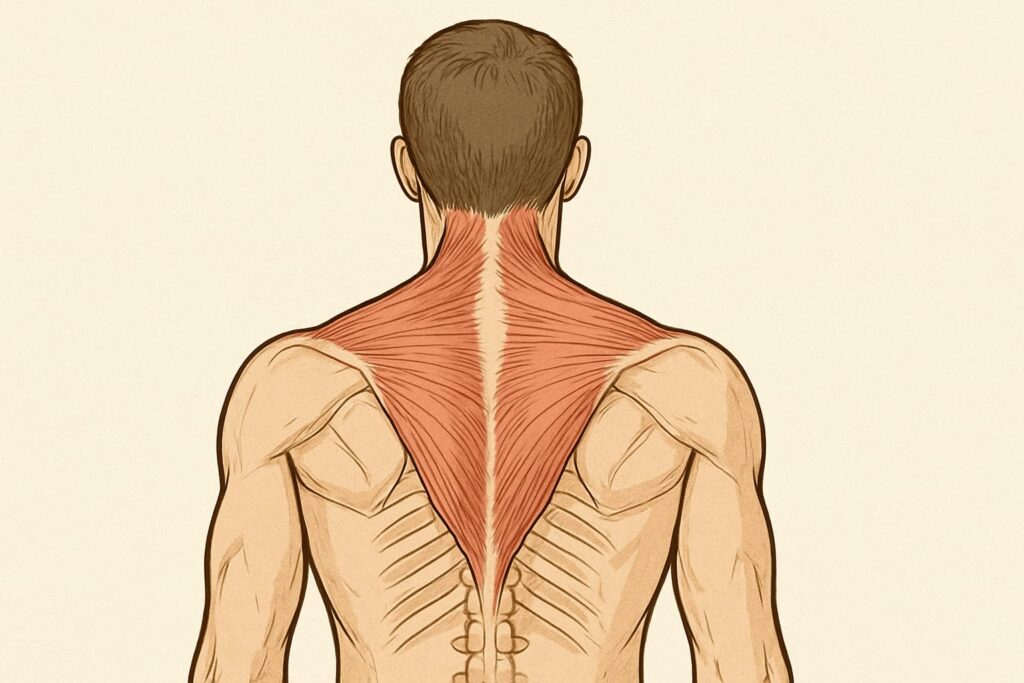The Best Exercises for Trapezius: With and Without Weights
When it comes to building an impressive upper body, the trapezius muscles often don’t get the attention they deserve. Yet, a strong trapezius is essential not only for posture and injury prevention but also for overall strength. In this guide, we will explore the best exercises for trapezius, both with weights and without equipment, so you can develop this key muscle group no matter where you train.

Why Focus on the Trapezius?
The trapezius, commonly called the “traps,” is a large diamond-shaped muscle that extends from the base of the skull, across the shoulders, and down the mid-back. This muscle is responsible for moving, rotating, and stabilizing the shoulder blades and supporting neck movement. Without strong traps, your upper body strength and mobility are limited.
Moreover, well-developed traps contribute to a broader, more powerful look. Whether you’re a beginner or advanced lifter, including the best exercises for trapezius in your program will help balance strength and aesthetics.
Anatomy of the Trapezius
Understanding the trapezius helps you target it effectively:
- Upper traps: Located near the neck, they control shoulder elevation (shrugging).
- Middle traps: Across the upper back, they retract the shoulder blades.
- Lower traps: Extend down the mid-back and help with scapular depression and stability.
The variety of functions means the best exercises for trapezius should include movements that hit all three regions.
Benefits of Training the Trapezius
Including trapezius exercises offers multiple advantages:
- Improved posture – Reduces rounded shoulders caused by desk jobs.
- Neck and shoulder stability – Essential for pressing and pulling strength.
- Injury prevention – A strong trapezius supports the rotator cuff and reduces strain.
- Better aesthetics – Builds the “yoked” look athletes are known for.
Because of these benefits, prioritizing the best exercises for trapezius is not just about looking strong but staying healthy long term.
Best Exercises for Trapezius With Weights
Weight training allows you to overload the traps effectively. Here are the top options:
Barbell Shrugs
Barbell shrugs are one of the best exercises for trapezius because they directly target the upper portion. Simply hold a barbell at hip height and shrug your shoulders upward as high as possible.
Tips:
- Keep arms straight.
- Avoid rolling your shoulders.
- Pause briefly at the top for maximum contraction.
Dumbbell Shrugs
Similar to the barbell version, dumbbell shrugs provide a greater range of motion. They also reduce imbalances between the left and right traps.
Why it works: Each arm moves independently, forcing better engagement.
Rack Pulls
Often overlooked, rack pulls (a partial deadlift) overload the traps tremendously. By setting the bar at knee or mid-thigh level, you focus more on the upper back and traps rather than the legs.
Pro tip: Use heavy weight to maximize trap activation, but maintain strict form.
Upright Rows
Upright rows are among the best exercises for trapezius when performed with correct technique. Holding a barbell or dumbbells, pull the weight up toward your chest while keeping elbows high.
Variation: Wide-grip upright rows reduce shoulder impingement risk while still targeting the traps.
Overhead Barbell Press
Although primarily a shoulder exercise, pressing overhead recruits the upper traps significantly. Stabilizing the weight overhead challenges the entire trapezius, especially the upper fibers.
Deadlifts
Deadlifts might not look like a trap exercise, but they heavily recruit the entire trapezius. From stabilizing the spine to holding the bar, the traps work isometrically throughout the lift.
Transition tip: If you want a compound movement that hits multiple muscles, deadlifts are indispensable.
Farmer’s Carries
Carrying heavy dumbbells or kettlebells while walking engages the traps, forearms, and core simultaneously. It is a functional and practical way to strengthen the traps.
Best Exercises for Trapezius Without Weights
Not everyone has access to a gym, but you can still train effectively. Here are the best bodyweight options:
Scapular Push-Ups
This push-up variation isolates the traps and serratus anterior. Instead of bending the elbows, retract and protract your shoulder blades while keeping arms straight.
Wall Angels
Standing with your back against the wall, move your arms in a “snow angel” motion while keeping your spine flat. This strengthens the lower traps and improves posture.
Inverted Rows
If you have a bar or sturdy table, inverted rows become one of the best exercises for trapezius without weights. The middle traps are heavily activated during scapular retraction.
Handstand Holds
Even without moving, holding a handstand recruits the upper traps significantly. If you are new, try wall-supported handstands.
Resistance Band Shrugs
With minimal equipment, resistance bands replicate the shrug motion effectively. They provide continuous tension, making them ideal for home workouts.
Programming the Best Exercises for Trapezius
Now that you know the options, how should you structure them?
- Beginners: Start with 2–3 trap exercises, twice per week.
- Intermediate lifters: Combine heavy lifts (deadlifts, rack pulls) with isolation moves (shrugs).
- Advanced athletes: Use progressive overload, adding volume and intensity over time.
Sample Routine:
- Deadlifts – 3 sets of 5 reps
- Barbell Shrugs – 4 sets of 12 reps
- Upright Rows – 3 sets of 10 reps
- Farmer’s Carries – 2 rounds of 1 minute walk
On bodyweight days, swap deadlifts and shrugs for handstand holds and wall angels.
Common Mistakes When Training the Trapezius
Even with the best exercises for trapezius, mistakes can reduce results or cause injury. Avoid these pitfalls:
- Over-shrugging with poor form – Focus on controlled, quality reps.
- Neglecting lower traps – Don’t just train the upper section.
- Using too much weight – Heavy loads with sloppy form stress the neck.
- Skipping mobility work – Flexibility is essential for balanced trap growth.
Stretching and Mobility for Healthy Traps
Strong traps are vital, but flexibility prevents stiffness. After performing the best exercises for trapezius, add stretching:
- Neck stretches – Tilt your head side to side to release upper traps.
- Doorway pec stretch – Opens chest to reduce forward shoulders.
- Cat-cow stretch – Mobilizes the spine and trapezius.
Doing these after training enhances recovery and posture.
Final Thoughts on the Best Exercises for Trapezius
The trapezius is more than just a vanity muscle. It stabilizes, supports, and strengthens your upper body. Whether you lift heavy in the gym or train at home without equipment, the best exercises for trapezius will help you build strength, improve posture, and reduce the risk of injury.
Consistency is key. By combining weighted and bodyweight variations, and avoiding common mistakes, you will see significant progress in both strength and appearance.
